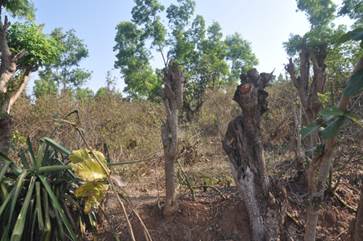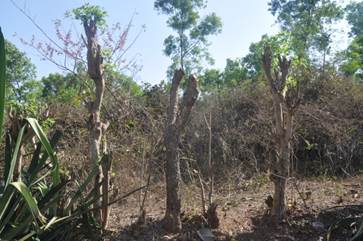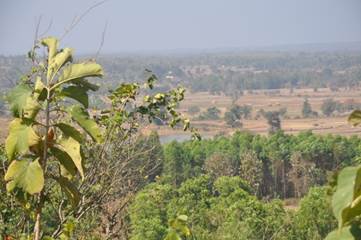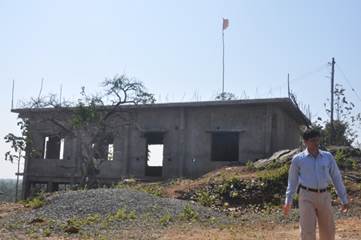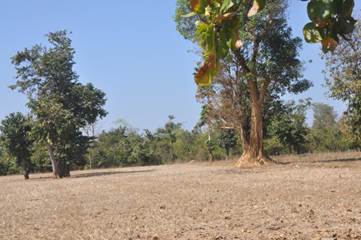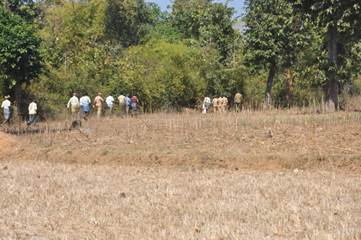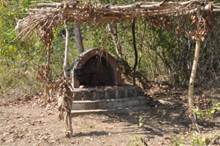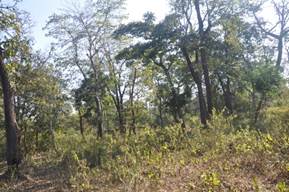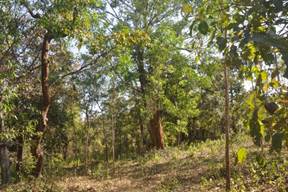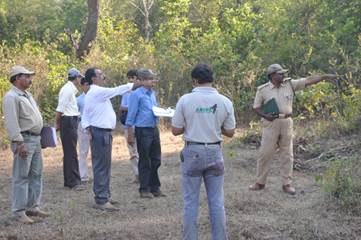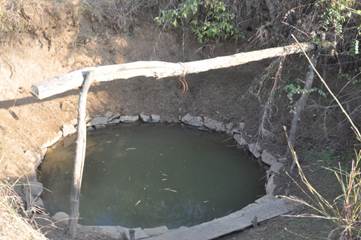|
|
ENVIS Technical Report 97, July 2015 |
 |
Conservation Of Fragmented Forests In Banavasi Range, Sirsi Forest Division, Kanara Circle |
 |
Energy and Wetlands Research Group, Centre for Ecological Sciences, Indian Institute of Science, Bangalore – 560012, India.
*Corresponding author: cestvr@ces.iisc.ac.in
CHIKKADUGLI FOREST; BASI PANCHAYAT
Survey no : 22 Area: 46.84 ha (Minor Forest)
30 38.36 ha (Proper Forest)
Protection required : CPT for 2.50 km length
Village Forest Committee: No
Description of forest: The forest is today of moist deciduous nature, whereas the rainfall of 1800 mm could have been good enough for semi-evergreen forest. The forest is subjected to desiccation due to canopy gaps, increased levels of human interference and probably sporadic fires. Today deciduous tree species dominate the vegetation.
Of the notable trees are Adina cordifolia, Alseodaphne semecarpifolia, Aporosa lindleyana, Buchanania lanzan, Butea monospema, Careya arborea, Cordia myxa, Dalbergia latifolia, Diospyros melanoxylon, Ficus spp., Helictres isora, Holarrhena pubescens, Lannea coromandelica, Mangifera indica, Phyllanthus emblica, Pterocarpus marsupium, Syzygium cumini, Tabernamontana heyneana, Terminalia bellirica, T. paniculata T. tomentosa, Xantolis tomentosa, Xylia xylocarpa, etc. Bambusa arundinacea is frequent in the forest; weed infestation is high in the openings. Among the shrubs and climbers noticed were Calycopteris floribunda, Carissa carandas, Embelia tsjeriam-cottam, Hemidesmus indicus, Ichnocarpus frutescens, Jasminim malabaricum, Smilax zeylanica, Zizyphus rugosa etc.
Threats: Extraction pressures and encroachments
Future management suggested
-
Requirement of cattle-proof trench (CPT): CPT for 2.5 km is recommended (see figure). CPT will be the immediate solution for preventing further encroachments
-
Minimum basal area to be targeted: Under proper protection and management the basal area of trees could easily be increased to the least 35 sq.m/ha through replanting, natural regeneration and proper protection. Forest has good potential for regeneration under protection of natural growth.
-
Species recommended for planting/natural regeneration: To be chosen from the indicative list
-
VFC formation: Constitution of VFC is very critical.
-
Awareness programmes: To be conducted periodically in the village
-
Meeting fuelwood crisis: Of the 85 ha forest, about 25 ha may be used for fuelwood species. The remaining to be earmarked as conservation area and no biomass/NTFP to be harvested till forest recovery. Fast growing species and wood gasifier recommended. Households with adequate number of cattle should be assisted to install gobargas plants in. Astra stoves and solar devices (particularly for hot water) recommended to save use of fuelwood from forest. All these steps are dissuade people from depending heavily on forests for routine biomass needs.
-
Village Forest Committee: VFC has to be constituted for better management of this fragmented and highly impacted forest.
Table 1: Species recommended for planting in the forest fragments of Banavasi Forest Range
No |
Scientific name |
Local name |
Importance |
|
Fuel wood block |
1 |
Albizzia chinensis |
Hottebage |
Fuel wood; leaves as fodder for goats; slope stabilization |
2 |
Anogeissus latifolia |
Dindiga |
One of the toughest and useful woods; gum for tanning and calico printing; leaves as fodder; good for rocky and dry areas; leaves for silkworm to produce tassar silk |
3 |
Bridelia retusa |
Kandakasana |
Timber and firewood, leaves for manure. Bark and leaves important in ayurveda |
4 |
Cordia wallichi |
Challehannu |
Fruits eaten by bears; cattle feed on leaves; fruits edible. Fruits medicinal; for pickling |
5 |
Dillenia pentagyna |
Kanigale |
Malabar giant squirrel feed on fruits; monkeys and birds feed on fruits. Plant parts used in ayurvedic medicine |
6 |
Diospyros melanoxylon |
Tumri |
Drought resistant tree. Good fuel and timber; wood valued for carving; leaves as NTFP. Fruit bats, birds, particularly hornbills feed on fruits. Fruits edible to humans; leaves make fodder; |
7 |
Grewia tilifolia |
Tadasalu |
Malabar giant squirrel feed on bark and leaves |
8 |
Melia dubia |
Hebbevu |
Fast growing large tree; produces useful timber and firewood. High biomass improves soil fertility, where it grows densely good watershed protection can be expected. Bioinsecticide from leaves for chicken pests; dry leaves when burns repels mosquitos; seed oil insect repellent like neem oil. It can yield upto 40 tons biomass/year for 10 years and is a good solution for firewood crisis in Banavasi region; good for biomass gasification plant |
9 |
Xylia xylocarpa |
Jambe |
Fuelwood and leaf manure, bark medicinal, N-fixer; favours regrowth of evergreens. Malabar giant squirrel feed on seeds |
|
Conservation block |
1 |
Aegle marmelos |
Bilpatri |
Sacred tree; Leaves, fruit pulp medicinal; leaves have sale value; medicated oil from leaves; gum from fruit added to watercolors; oil distilled from rind for flavouring hair oil; fruit shell for handicrafts; yellow dye from fruit |
2 |
Alangium salvifolium |
Ankolemara |
Edible fruits; roots very medicinal, leaves and fruits also medicinal; plant is rich in alkaloids; fruits eaten by Roseringed parakeet, Indian myna, Common babbler |
3 |
Alseodaphne semecarpifolia |
Mashe |
Re-establishment of evergreen forest |
4 |
Artocarpus gomezianus |
Waate-huli |
Yellow dye from wood and fruits, sour fruits dried and sold like tamarind |
5 |
Artocarpus heterophyllus |
Halasu |
Edible fruit and seeds, chips prepared from fruits, tender fruits as vegetable. Leaves and fruit waste as fodder; plant parts, including latex, medicinal; orange-red dye from wood; useful for re-establishment of evergreen nature; strong wind-break tree; many herbivores feed on the fruits |
6 |
Buchanania lanzan |
Nurkalu |
Nuts edible, for making sweet-meats. Good for afforesting bare hill slopes; roots, leaves and fruits medicinal; char oil extracted from fruit medicinal; nuts have export value |
7 |
Butea monosperma |
Muttaga, Palasa |
Roots, leaves, flowers, seeds, gum and bark reputed in medicines. Tree ornamental; dry leaves sold as eating plates. Fabric dye from flowers. Tree considered sacred. |
8 |
Carallia brachiata |
Andamurgila |
Large tree for re-establishment of evergreen forests. Stem bark wound healing; fruits and seeds edible |
9 |
Caryota urens |
Bainymara |
Palm of great ecological significance. Palm civets disperse seeds; juice from flowers (palm toddy) made into palm jiggery. Flowers produce nectar and favours apiculture; leaf fibre for brushes; old stem for timber; starch from stem pith as food of medicinal value |
10 |
Cassia fistula |
Kakkemara |
Tree with beautiful flowers; flowers provide pollen to honey bees and leaf nectaries provide nectar. Fruit pulp/seeds reputed in ayurvedic medicines. Flowers and bark medicinal |
11 |
Ficus benghalensis |
Aala |
Large tree useful for forest restoration. Used in ayurvedic medicines; many birds and mammals feed on fruits; keystone species; leaves for fodder |
12 |
Ficus callosa |
Neeruvatee |
Fore evergreen forest restoration; ecosystem value- birds and bats feed on the fruits. |
13 |
Flacourtia montana |
Hannu-sampige |
Good for evergreen forest restoration; fruit edible, has market value |
14 |
Hydnocarpus pentandra |
Toratte |
Good for evergreen forest restoration. Seeds and seed oil reputed in ayurveda for skin diseases |
15 |
Madhuca indica |
Ippimara |
Petals used as food; seed oil for cosmetics and soap; as biofuel; fat used in chocolates and sweets; oil cake as fertilizer; plant medicinal; leaves have fodder value; seed as NTFP. Fruits eaten by many wild animals and birds |
16 |
Mangifera indica |
Maavu |
Good for evergreen forest restoration; wild mangoes like appemidi used for pickling can promote cottage industry |
17 |
Phyllanthus emblica |
Nellikai |
Highly valued forest produce; fruit as food, for pickling; reputed as highly medicinal |
18 |
Pongamia pinnata |
Honge |
Fast growing evergreen tree; can grow on poor soils; good for nitrogen enrichment; leaves make good green manure and has pesticide property; seed oil for blending with diesel; one tree can produce up to 40 kg seeds/year |
19 |
Pterocarpus marsupium |
Honnemara |
Timber, adds soil fertility, leaves for fodder, latex medicinal. |
20 |
Santalum album |
Sreegandha |
Many saplings and treelets in Rangapura forest, Badangod; needs protection through VFC participation |
21 |
Sapindus laurifolius |
Antuvaala |
Soapnut fruit is NTFP; flowers source of highly priced honey |
22 |
Syzygium cumini |
Neerale |
Good for evergreen forest re-establishment; edible fruits; plant parts, fruits and seeds have medicinal values. Large fruited varieties recommended or planting |
23 |
Tamarindus indicus |
Hunsemara |
Tamarind fruit could be a good source of income f locals. Tree recommended for planting alongside CPT |
24 |
Terminalia bellirica |
Tari |
Fruits rich in tannin, dye from fruits for fabrics; fruit very medicinal; seed oil for soap |
25 |
Zanthoxylum rhetsa |
Jumminkaimara |
Fruit an NTFP; used for falvouring curries. |
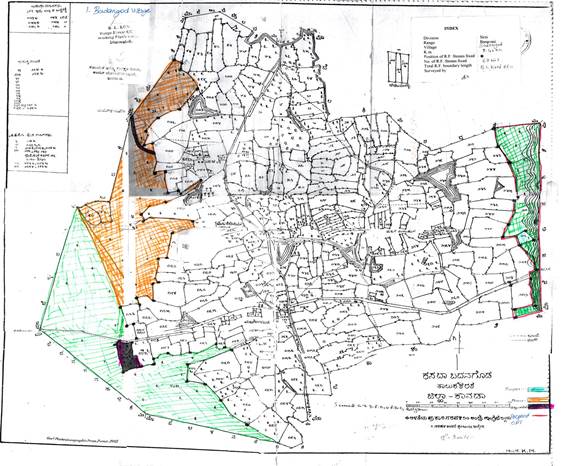
Figure 1. Badangod village forest (towards right border), CPT marked
Figure 2 & 3: Degraded state of the Badangod forest
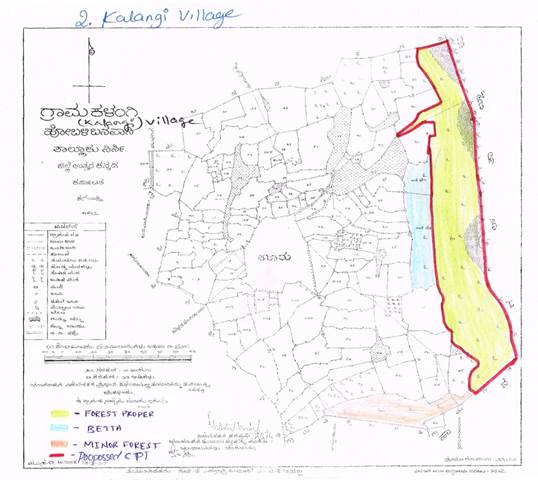
Figure 3: Kalangi village showing forest area to be protected by CPT
Figure 4: Degraded Kalangi forest with water body below. Figure 5: Gutavva temple on the hill top.
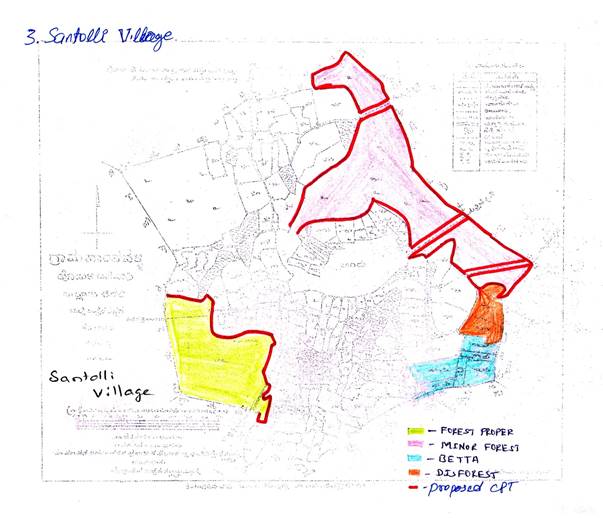
Figure 6: Santolli village showing forest patches and proposed CPT
Figure 7: Cultivation expanding into the forest Figure 8: Santolli forest
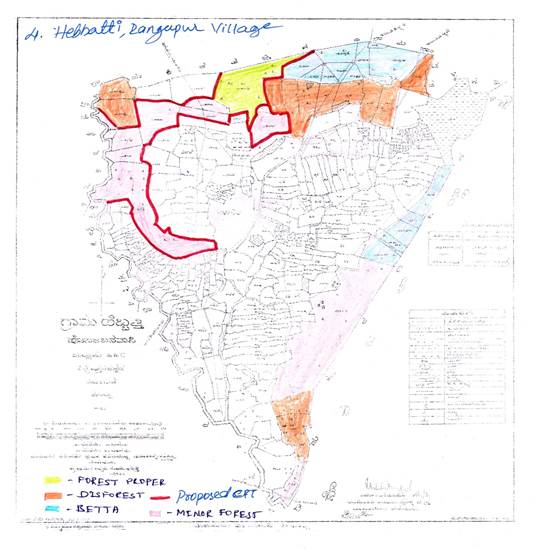
Figure 9: Hebbati-Rangapur forest showing forest area proposed to be protected by CPT
Figure 10. A base burned tree in encroached area; Figure 11: A sacred place within forest
Figure 12: Ring barked tree in encroached area
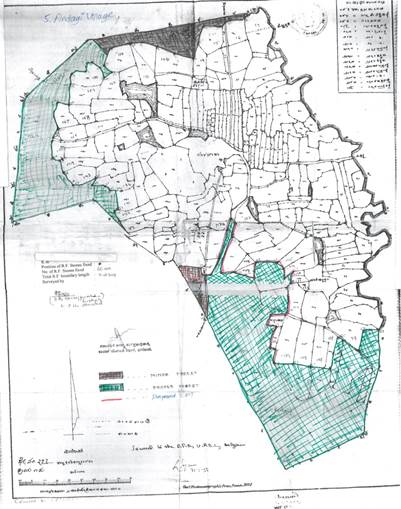
Figure 13: Andagi village map teak plantation (south side) requiring CPT.
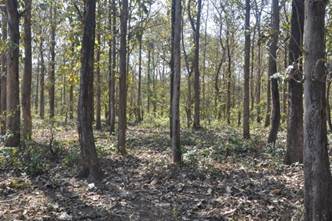
Figure 14: Teak plantation requiring CPT protection
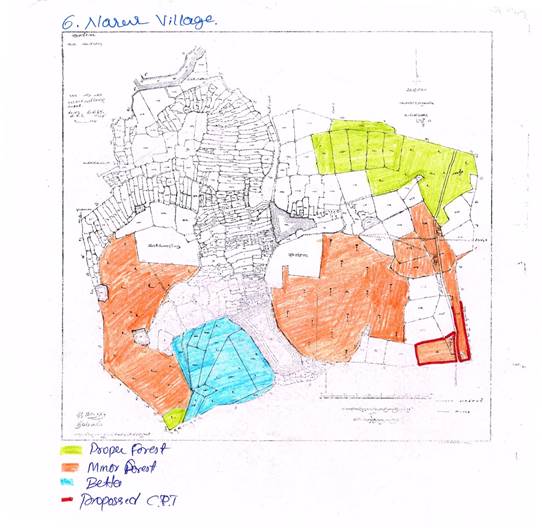
Figure 15: Narur village showing forest area requiring CPT (bottom-south corner)
Figures 16 & 17: Views of Narur forest
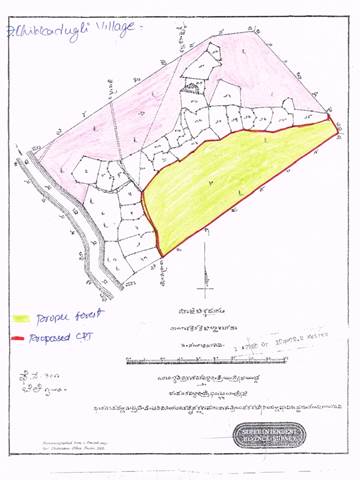
Figure 18: Chikkadugli village showing forest area requiring CPT
Figure 19: Studying the forest; Figure 20: A well inside forest showing high water table in January
|
Subash Chandran M.D.
Energy & Wetlands Research Group, Centre for Ecological Sciences, Indian Institute of Science, Bangalore – 560 012, INDIA.
E-mail: mds@ces.iisc.ac.in
Rao G. R.Energy & Wetlands Research Group, Centre for Ecological Sciences, Indian Institute of Science, Bangalore – 560 012, INDIA.
E-mail: grrao@ces.iisc.ac.in
T.V. Ramachandra
Centre for Sustainable Technologies, Centre for infrastructure, Sustainable Transportation and Urban Planning (CiSTUP), Energy & Wetlands Research Group, Centre for Ecological Sciences, Indian Institute of Science, Bangalore – 560 012, INDIA.
E-mail : cestvr@ces.iisc.ac.in
Tel: 91-080-22933099/23600985,
Fax: 91-080-23601428/23600085
Web: http://ces.iisc.ac.in/energy
Citation: Subash Chandran M.D., Rao G R and Ramachandra T V, 2015., , Sahyadri Conservation Series 50, ENVIS Technical Report 97, CES, Indian Institute of Science, Bangalore 560012
| Contact Address : |
| |
Dr. T.V. Ramachandra
Energy & Wetlands Research Group,
Centre for Ecological Sciences,
New Biological Sciences Building, 3rd Floor, E-Wing, Lab: TE15
Indian Institute of Science, Bangalore – 560 012, INDIA.
Tel : 91-80-22933099 / 22933503(Ext:107) / 23600985
Fax : 91-80-23601428 / 23600085 / 23600683 [CES-TVR]
E-mail : cestvr@ces.iisc.ac.in, energy@ces.iisc.ac.in,
Web : http://wgbis.ces.iisc.ac.in/energy |
|



